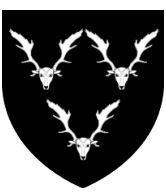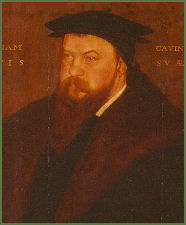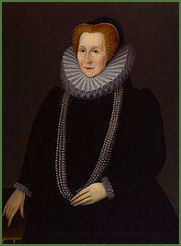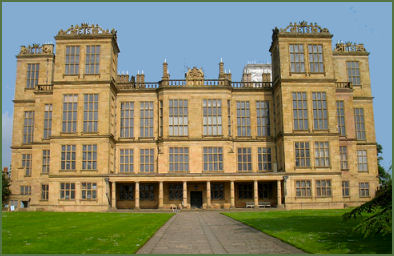The Cavendish Family- Dukes of Devonshire
 The Dukes of Devonshire descend from Sir John Cavendish, whose name derives from the village of Cavendish in Suffolk, where he held lands in the fourteenth century, he was descended from the Norman knight, Robert de Gernon, Robert's son, also called Robert de Gernon, of Grimston Hall in Suffolk, married the heiress of John Potton of Cavendish and obtained the estates of Cavendish. As a result, his four sons changed their father's surname to that of the estate.
The Dukes of Devonshire descend from Sir John Cavendish, whose name derives from the village of Cavendish in Suffolk, where he held lands in the fourteenth century, he was descended from the Norman knight, Robert de Gernon, Robert's son, also called Robert de Gernon, of Grimston Hall in Suffolk, married the heiress of John Potton of Cavendish and obtained the estates of Cavendish. As a result, his four sons changed their father's surname to that of the estate.
Sir John Cavendish served as Chief Justice of the King's Bench from 1372 to 1381, during the reign of King Richard II and met his end in the Peasants' Revolt. Wat Tyler, the leader of the revolt, was struck down by William Walworth, lord mayor of London, during negotiations on 15th June, but John Cavendish, the second son of the Chief Justice, delivered the finishing blow. The father, Sir John Cavendish, was pursued by the peasants bent on revenge. Cavendish fled to a church where he pleaded sanctuary by desperately grasping the handle of the door, but was taken to the market place at Bury St. Edmunds and beheaded on 15th June 1381.
 John's grandson Thomas Cavendish (died 1524), became a senior financial official, the clerk of the pipe, in the Court of Exchequer, during the reign of King Henry VIII. Thomas' son, George Cavendish was Thomas Cardinal Wolsey's biographer, another son, George's younger brother, Sir William Cavendish, (pictured right) gained great wealth from his position in the Exchequer during the Dissolution of the Monasteries. His third wife was the indomitable Bess of Hardwick, (pictured below left) who rose from humble origins to become one of the most powerful people in the court of Queen Elizabeth I. She was married four times, each time gaining more wealth. William and Bess produced eight children, he had a total of 16 children by three wives. They bought the Chatsworth estate for £600 in 1549, and in 1552 began to build the first house on the site.
John's grandson Thomas Cavendish (died 1524), became a senior financial official, the clerk of the pipe, in the Court of Exchequer, during the reign of King Henry VIII. Thomas' son, George Cavendish was Thomas Cardinal Wolsey's biographer, another son, George's younger brother, Sir William Cavendish, (pictured right) gained great wealth from his position in the Exchequer during the Dissolution of the Monasteries. His third wife was the indomitable Bess of Hardwick, (pictured below left) who rose from humble origins to become one of the most powerful people in the court of Queen Elizabeth I. She was married four times, each time gaining more wealth. William and Bess produced eight children, he had a total of 16 children by three wives. They bought the Chatsworth estate for £600 in 1549, and in 1552 began to build the first house on the site.
 After her husband's death Bess married George Talbot, 6th Earl of Shrewsbury (c. 1528-90) in 1567. Queen Elizabeth I appointed Shrewsbury as custodian of Mary, Queen of Scots, who was a prisoner at Chatsworth at various times between 1569 and 1584. During a visit of the Countess of Lennox in 1574, Bess engineered an advantageous match between her daughter, Elizabeth Cavendish and Charles Stuart, the Countess' son and the younger brother of Henry, Lord Darnley, who was the husband of Mary, Queen of Scots. Arbella Stuart, once vetted as a possible succesor to Queen Elizabeth I, was the only child of this marriage.
After her husband's death Bess married George Talbot, 6th Earl of Shrewsbury (c. 1528-90) in 1567. Queen Elizabeth I appointed Shrewsbury as custodian of Mary, Queen of Scots, who was a prisoner at Chatsworth at various times between 1569 and 1584. During a visit of the Countess of Lennox in 1574, Bess engineered an advantageous match between her daughter, Elizabeth Cavendish and Charles Stuart, the Countess' son and the younger brother of Henry, Lord Darnley, who was the husband of Mary, Queen of Scots. Arbella Stuart, once vetted as a possible succesor to Queen Elizabeth I, was the only child of this marriage.
One of the sons of Bess and William Cavendish, Sir Charles Cavendish (1553–1617), was the father of William Cavendish, 1st Duke of Newcastle-upon-Tyne, another son, Henry Cavendish, was the ancestor of the Barons Waterpark. The second and favourite son, William Cavendish, inherited a vast fortune on Bess' death in 1608, including four important houses - Worksop and Oldcotes in Nottinghamshire, Chatsworth, and Hardwick Hall. He was a politician and a supporter of the colonialization of Virginia. In 1605 he was raised to the peerage as Baron Cavendish of Hardwick, and in 1618 he was further enobled when he was made Earl of Devonshire by King James I, mainly due to the representations of his niece, Arbella Stuart.
 William was succeeded by his eldest son, William Cavendish, the second Earl of Devonshire. A notorious spendthrift, he served as Lord-Lieutenant of Derbyshire and was a patron of the philosopher Thomas Hobbes who was his childhood tutor at Chatsworth House. He married Christiana Bruce, daughter of Edward Bruce, 1st Lord Kinlos and on his early death his estates passed to his son, William Cavendish, the third Earl of Devonshire, a friend of John Evelyn, supported the Royalist cause during the Civil War. Colonel Charles Cavendish, his younger brother, was killed in battle in 1643. The third Earl himself died in 1628 leaving behind a trail of debts and lawsuits and was was in turn succeeded by his son, William Cavendish, the fourth Earl, described by Horace Walpole as 'a patriot among the men, a gallant among the ladies', became a strong supporter of the Glorious Revolution and was amongst the signatories of an invitation to William of Orange. After the revolution, Cavendish was a leading Whig, serving as William's Lord Steward, in 1694 he was created Marquess of Hartington and Duke of Devonshire by a grateful William III.
William was succeeded by his eldest son, William Cavendish, the second Earl of Devonshire. A notorious spendthrift, he served as Lord-Lieutenant of Derbyshire and was a patron of the philosopher Thomas Hobbes who was his childhood tutor at Chatsworth House. He married Christiana Bruce, daughter of Edward Bruce, 1st Lord Kinlos and on his early death his estates passed to his son, William Cavendish, the third Earl of Devonshire, a friend of John Evelyn, supported the Royalist cause during the Civil War. Colonel Charles Cavendish, his younger brother, was killed in battle in 1643. The third Earl himself died in 1628 leaving behind a trail of debts and lawsuits and was was in turn succeeded by his son, William Cavendish, the fourth Earl, described by Horace Walpole as 'a patriot among the men, a gallant among the ladies', became a strong supporter of the Glorious Revolution and was amongst the signatories of an invitation to William of Orange. After the revolution, Cavendish was a leading Whig, serving as William's Lord Steward, in 1694 he was created Marquess of Hartington and Duke of Devonshire by a grateful William III.
William Cavendish, second Duke of Devonshire was the eldest son of the first Duke. A connoisseur of the arts, and was responsible for the formation of an outstanding collection which included paintings, Old Master drawings and prints and ancient coins. He held political office as Lord President of the Council and Lord Privy Seal and was also Lord-Lieutenant of Devonshire. He married The Hon. Rachel Russell (1674–1725), daughter of William, Lord Russell on 21 June 1688. His second son, Lord Charles Cavendish, was a politician and scientist. Charles' son Henry Cavendish was an influential scientist noted for his discovery of hydrogen.
The second Duke's eldest son, yet another William Cavendish, the third Duke, served as Lord Privy Seal, as Lord Steward of the Household and as Lord-Lieutenant of Ireland. He bears the distinction of being the most recent common ancestor of Prince Charles and his first wife, Lady Diana Spencer. The couple were seventh cousins once removed as Charles descends (through his grandmother, the Queen mother) from William’s son, the 4th Duke, while Diana was descended from William’s daughter, Lady Elizabeth Cavendish.
His son, William Cavendish the fourth Duke was a prominent politician, he married Charlotte Boyle, 6th Baroness Clifford, daughter of the famous architect Richard Boyle, 3rd Earl of Burlington, their third and youngest son Lord George Cavendish was created Earl of Burlington in 1831. Their daughter, Lady Dorothy Cavendish, married Prime Minister William Cavendish-Bentinck, 3rd Duke of Portland and became an ancestor of Queen Elizabeth II.
 William Cavendish, fifth Duke of Devonshire, William's eldest son, took as his first wife the famous society beauty, Lady Georgiana Spencer, (pictured right) eldest daughter of John, 1st Earl Spencer. Famous not only for her marital arrangements, her catastrophic affairs, her beauty and sense of style, but also for her love of gambling and became addicted to gambling and extravagent parties. She borrowed heavily from her friends to fund these habits and used her influence to borrow more from such people as Thomas Coutts of Coutts bank. The marriage produced theree children, a son William Cavendish and two daughters: Lady Georgiana "Little G" Cavendish, later the Countess of Carlisle and Lady Harriet "Harryo" Cavendish, later the Countess Granville. Bess also had an illegitimate daughter Eliza Courtney, through her affair with Charles Grey, 2nd Earl Grey. Georgiana was forced to give her to Grey's parents. Eliza married Lieutenant-Colonel Robert Ellice and named her eldest daughter Georgiana.
William Cavendish, fifth Duke of Devonshire, William's eldest son, took as his first wife the famous society beauty, Lady Georgiana Spencer, (pictured right) eldest daughter of John, 1st Earl Spencer. Famous not only for her marital arrangements, her catastrophic affairs, her beauty and sense of style, but also for her love of gambling and became addicted to gambling and extravagent parties. She borrowed heavily from her friends to fund these habits and used her influence to borrow more from such people as Thomas Coutts of Coutts bank. The marriage produced theree children, a son William Cavendish and two daughters: Lady Georgiana "Little G" Cavendish, later the Countess of Carlisle and Lady Harriet "Harryo" Cavendish, later the Countess Granville. Bess also had an illegitimate daughter Eliza Courtney, through her affair with Charles Grey, 2nd Earl Grey. Georgiana was forced to give her to Grey's parents. Eliza married Lieutenant-Colonel Robert Ellice and named her eldest daughter Georgiana.
Georgiana died deeply in debt on 30 March 1806, at the age of 48, from an abscess of the liver. At the time of her death, Georgianed today's equivalent of £3,720,000. After her death the Duke married his long term mistress, Lady Elizabeth Foster, this marriage left no legitimate issue. A son, Augustus, was given the surname Clifford and became Sir Augustus Clifford and rose to senior rank in the navy and a daughter, Caroline Rosalie St Jules.
William George Spencer Cavendish, the sixth Duke, (right) the only son of William and Georgiana, known as 'Hart' in the family, was a close friend of the Prince Regent and of Charles Dickens, he supported Catholic emancipation, the abolition of slavery and reduced factory working hours. He befriended Sir Joseph Paxton and appointed him head gardener at Chatsworth House in 1826. Paxton greatly expanded the gardens at Chatsworth, including the construction of a 300 feet long conservatory, which served as a model for The Crystal Palace.
 The sixth Duke was known as the 'Bachelor Duke' as he never married and on his death at Hardwick Hall in 1858 he was succeeded as Duke of Devonshire by his first cousin once removed, William Cavendish, second Earl of Burlington, who became the seventh Duke. He was the son of William Cavendish, eldest son of the first Earl of Burlington, youngest son of the fourth Duke. In 1829, he married Blanche Georgiana Howard (11 January 1812 - 27 April 1840), daughter of George Howard, 6th Earl of Carlisle and Georgiana Cavendish, daughter of the 5th Duke of Devonshire, and Georgiana Spencer. Their three sons all became distinguished politicians; the eldest, known after 1858 by the courtesy title Marquess of Hartington, led the Liberal Party and was asked three times to be Prime Minister by Queen Victoria; Lord Frederick Cavendish was briefly Chief Secretary for Ireland and was assassinated in 1882 in the Phoenix Park Murders. Lord Edward Cavendish was MP for West Derbyshire.
The sixth Duke was known as the 'Bachelor Duke' as he never married and on his death at Hardwick Hall in 1858 he was succeeded as Duke of Devonshire by his first cousin once removed, William Cavendish, second Earl of Burlington, who became the seventh Duke. He was the son of William Cavendish, eldest son of the first Earl of Burlington, youngest son of the fourth Duke. In 1829, he married Blanche Georgiana Howard (11 January 1812 - 27 April 1840), daughter of George Howard, 6th Earl of Carlisle and Georgiana Cavendish, daughter of the 5th Duke of Devonshire, and Georgiana Spencer. Their three sons all became distinguished politicians; the eldest, known after 1858 by the courtesy title Marquess of Hartington, led the Liberal Party and was asked three times to be Prime Minister by Queen Victoria; Lord Frederick Cavendish was briefly Chief Secretary for Ireland and was assassinated in 1882 in the Phoenix Park Murders. Lord Edward Cavendish was MP for West Derbyshire.
The seventh Duke was succeeded by his second but eldest surviving son, Spencer Compton Cavendish, the eighth Duke. He was a noted statesman and the most famous member of the Cavendish family. He was asked three times by Queen Victoria to become Prime Minister, but each time declined to accept. He died childless and was succeeded by his nephew, Victor Christian William Cavendish, the ninth Duke, the eldest son of Lord Edward Cavendish, third son of the seventh Duke. In 1892 he married Lady Evelyn Fitzmaurice, daughter of the 5th Marquess of Lansdowne.
His eldest son, Edward William Spencer Cavendish, the tenth Duke married Lady Mary Gascoyne-Cecil. Their eldest son William John Robert Cavendish, Marquess of Hartington, married Kathleen Kennedy, sister of John Fitzgerald Kennedy, the future President of the United States, she was killed in an aircrash and lies buried along with other members of the Cavendish family in the churchyard of St Peter's at the village of Edensor on the Chatsworth estate.
President Kennedy visited her grave in 1963 shortly before his own death. The Marquess of Hartington was killed in action in Belgium during the Second World War in 1944, the couple had no children and the title and estates passed to the second son, Andrew Robert Buxton Cavendish, 11th Duke of Devonshire, in 1941 he married the Hon. Deborah Mitford, daughter of Lord Redesdale. The couple had three children, Emma (b. 1943), Peregrine (b. 1944) and Sophia (b. 1957). He was suceeded by his son Peregrine Andrew Morny Cavendish, 12th Duke of Devonshire. He married Amanda Heywood-Lonsdale (b. 1944) in 1967 and they have three children, William, Earl of Burlington (b.1969), Lady Celina Cavendish (b. 1971) and Lady Jasmine Cavendish (b. 1973).
Back to Cheshire and Derbyshire history menu
